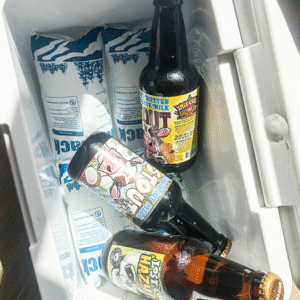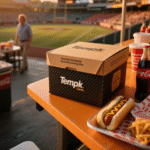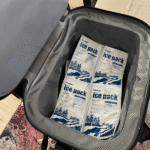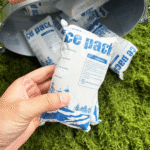Comment emballer la glace sèche dans une glacière en toute sécurité (2025)
Si vous avez besoin de résultats gelés‑solides, apprentissage comment emballer de la neige carbonique dans une glacière la bonne manière est essentielle. Préchauffeur, envelopper des blocs, Ajouter une barrière, emballage, et évacuer en toute sécurité. Faites cela et vous conserverez les aliments congelés 24 à 72 heures, respecter la limite de 2,5 kg des compagnies aériennes, et évitez les couvercles fissurés ou les dégâts détrempés. Ce guide fusionne et met à niveau trois brouillons que vous avez fournis en un seul article prêt pour 2025..
-
Comment emballer de la neige carbonique dans une glacière pendant 24 à 72 heures avec un simple, méthode reproductible
-
De quelle quantité de neige carbonique vous avez réellement besoin par taille de refroidisseur et durée du voyage
-
Comment emballer de la neige carbonique dans une glacière pour les vols sous la règle des 2,5 kg
-
Comment emballer de la neige carbonique dans une glacière sans congeler les boissons utiliser des barrières et des options de disposition
-
Quoi acheter (Blocs vs Pellets) et comment éviter les pertes rapides et les brûlures alimentaires
Comment emballer de la neige carbonique dans une glacière pendant 24 à 72 heures?
Réponse courte: Pré-Chill la glacière, envelopper des blocs de glace carbonique, ajouter une barrière en carton/séparateur, emballer les articles hermétiquement, et gardez le colis aéré. Placez de la glace carbonique sur haut pour une tenue gelée la plus longue (puits d'air froid); mets-le sous une barrière en bas si vous voulez des articles frais, pas gelé. Les gants et les lunettes de protection ne sont pas négociables.
Pourquoi ça marche pour vous: La glace sèche est de –109°F (–78,5 ° C) et se tourne directement vers le gaz (pas d'eau de fonte). L'emballage réduit la perte de surface, des barrières protègent les doublures et les aliments, et un emballage serré coupe les poches d'air chaud qui « mangent » votre neige carbonique. Une glacière pré-refroidie et des blocs emballés peuvent étendre les performances de 24 jusqu'à ~ 72 heures selon la taille, météo, et ouvertures du couvercle.
Des dispositions qui simplifient la façon d'emballer de la glace carbonique dans une glacière
Pack supérieur (tenue maximale): Articles → barrière en carton → blocs de glace sèche enveloppés → fermer le couvercle
Pack inférieur (accès facile): Barrière → glace sèche enveloppée → barrière → articles
Pack latéral (deux zones): Séparateur avec glace carbonique d'un côté; boissons/produits de l'autre
| Option de mise en page | Mieux pour | Attentions | Ce que cela signifie pour vous |
|---|---|---|---|
| Pack supérieur | Prise gelée la plus longue | Accès un peu moins pratique | Utiliser pour la viande, poisson, glaces lors de voyages de plusieurs jours |
| Pack inférieur | Chargements mixtes « juste froids » | Maintien gelé plus court | Garde les collations accessibles; ajouter de la glace d'eau au-dessus de la barrière |
| Pack latéral | Split congelé/réfrigéré | Il faut un diviseur | Protège les filets tout en gardant les boissons non congelées |
Conseils pratiques pour économiser des kilos de neige carbonique
-
Préchauffeur: Chargez de glace sacrificielle pendant la nuit; jetez-le avant d'emballer de la neige carbonique.
-
Envelopper & barrière: Papier journal/kraft pour envelopper chaque bloc + tôle ondulée pour protéger les doublures.
-
Combler les lacunes: Les serviettes ou les bouteilles congelées éliminent les poches d'air et ralentissent la sublimation.
-
Ombre & fermer: Tenir à l'abri du soleil; ouvrir le couvercle rapidement et rarement.
Cas réel: Une glacière dure de 55 pintes, pré-réfrigéré toute la nuit avec une barrière en carton et un bloc top-pack de 10 lb, a conservé la crème glacée solide pendant environ 36 heures à 88-92°F avec des ouvertures minimales.
Comment emballer de la neige carbonique dans une glacière: de combien as-tu besoin?
Règle: 5–10 lb par 24h dans une glacière dure bien isolée. Passez à des refroidisseurs plus grands, à feu vif, accès fréquent, ou effets d'altitude de vol. De nombreux utilisateurs sur le terrain prévoient ~10lb par 15″ de longueur intérieure pour les cibles surgelées de plus de 24 à 48 heures.
Estimateur rapide (utilisez-le dans 30 secondes)
-
Durée du voyage (jours): D
-
Multiplicateur de classe plus cool: Petit=1, Moyen = 1,5, Grand=2, XL=3
-
Tarif de base: 7.5 LB / 24H (point médian de 5 à 10 lb)
-
Ajustements: +25% soleil brûlant; +10% accès fréquent
Formule: Pounds = D × 7.5 × Class × (1 + Adjustments)
Exemple: 48 H, Moyen, soleil brûlant (+25%), accès fréquent (+10%) → 2 × 7.5 × 1.5 × 1.35 ≈ 30 lb.
Tableau des tailles (cible gelée)
| Taille plus froide | 24 H | 48 H | Pour toi |
|---|---|---|---|
| Petit (20–35 pintes) | 5–10 lb | 10–20 lb | Collations/viande surgelées pour la nuit |
| Moyen (45–65 pintes) | 10–15 lb | 20–30 lb | Camper le week-end; garder le gibier/poisson solide |
| Grand (75–110 pintes) | 15–25 lb | 30–40lb | Recherches ou pannes sur plusieurs jours |
| Xl (150 qt+) | 25–40lb | 50–80lb | Exécutions prolongées; vérifier la compatibilité |
Les estimations supposent un impact difficile, Refroidisseur compatible avec la glace carbonique et emballage étanche.
Comment emballer de la neige carbonique dans une glacière pour les vols (2025)?
Réponse directe: ≤ 2,5 kg (5.5 kg) par passager / colis, emballage ventilé, et « Glace carbonique/dioxyde de carbone, marquage "solide" avec poids net. Demandez l’approbation de la compagnie aérienne avant de voyager. Ne jamais scotcher hermétiquement le refroidisseur. Utilisez des packs de gel pour protéger les articles lorsque la neige carbonique a disparu.
Liste de contrôle qui réussit l'acceptation:
-
Un refroidisseur dur qui évents (joint/drain fissuré selon les conseils du fabricant)
-
Étiquette: «Glace sèche» (ou «dioxyde de carbone, solide") + masse nette (Par exemple, "2,5 kg ou moins")
-
Approbation: Confirmez auprès de votre opérateur avant l'enregistrement
-
Calques: Envelopper les blocs + barrière + pack serré; espace aérien minimal
-
Transporter/Vérifier: Orienter pour évacuer; éviter les troncs scellés pendant les étapes au sol
Comment emballer de la neige carbonique dans une glacière sans congeler les boissons?
Barrière + placement + séparation. Gardez les boissons d'un côté avec de l'eau glacée; placez de la neige carbonique enveloppée derrière un diviseur ou au dessus avec une barrière sur des objets fragiles. Cela vous donne des sodas froids sans taches de « brûlure de congélation » sur les produits ou le fromage..
Bloc vs pellet: que devrais-tu acheter?
-
Blocs: La plus longue; moins de lacunes; idéal pour les objectifs de 48 à 72 heures
-
Granulés/Nuggets: Déroulement plus rapide; remplir les vides; idéal comme recharge autour des blocs
-
« Suppressions de compagnies aériennes »: Packs pré-dimensionnés pour atteindre ≤ 2,5 kg en vol
Emballez toujours et ajoutez une barrière dans les deux cas.
Glace sèche vs. packs de gel vs. glace ordinaire (ce qui est bon pour toi?)
| Méthode | Température typique | Dure environ* | Ce que cela signifie pour vous |
|---|---|---|---|
| Glace sèche | –78,5 ° C (–109 ° F) | ~18 à 24 heures par 5 à 10 lb | Véritable tenue gelée; pas d'eau de fonte; nécessite un EPI & ventilation |
| Packs de gel | ≈ –18°C à 0°C | 12–24h (en fonction de la taille/de l'isolation) | Manipulation plus sûre; réutilisable; idéal pour 2–8°C |
| Glace régulière | 0 ° C (32 ° F) | 4–18h | Bon marché, facile; ajoute du poids de l'eau et du désordre |
*Vos résultats varient selon l'isolation, soleil, et à quelle fréquence tu ouvres le couvercle.
Des règles de sécurité conviviales que vous ne pouvez pas ignorer
-
Jamais hermétique: L'accumulation de gaz peut faire gonfler les couvercles ou briser les conteneurs..
-
Aérer les véhicules et les pièces: Le CO₂ est invisible et peut déplacer l'oxygène; casser les vitres et éviter les coffres scellés.
-
Portez des gants isolés et une protection des yeux: Prévenir les engelures et les blessures par contact.
-
Jeter à l'air libre: Laissez les restes de glace carbonique se sublimer dans un endroit aéré, jamais dans les éviers ou dans les poubelles scellées..
2025 des développements qui changent la façon d'emballer de la neige carbonique dans une glacière
Quoi de neuf: Expéditeurs réutilisables, PCM (matériaux à changement de phase) pour voies 2–8°C, et Enregistreurs de température IoT maintenant compléter la glace carbonique. Mélange des équipes Panneaux VIP + PCMS réduire la masse de glace carbonique, réduire les déchets, et surveillez en temps réel. La dynamique de l’offre de CO₂ affecte toujours la disponibilité régionale, alors planifiez vos achats à l'avance pendant les hautes saisons.
Dernier en un coup d'œil
-
Les systèmes réutilisables sont en hausse: Moins de déchets PSE, coût inférieur à long terme
-
Surveillance intelligente: Les enregistreurs connectés à une application signalent une dérive précoce de la température
-
VIP + Combinaisons PCM: Des paquets plus petits, températures plus stables, moins d'excursions
Perspicacité du marché: Attendez-vous à une croissance constante dans le domaine de l’emballage et de la surveillance de la chaîne du froid jusqu’à la fin des années 2020. Pour toi, cela signifie plus d'options pour combiner la glace carbonique avec les PCM et les enregistreurs pour plus vert, des voyages plus sûrs.
FAQ
Combien de temps dure la glace sèche dans une glacière?
Dans une bonne glacière dure, plan 5–10lb pour ~24h. La chaleur et les ouvertures fréquentes raccourcissent cela; pré-refroidissement et emballage serré, prolongez-le.
Où doit aller la glace carbonique : en haut ou en bas?
Top pour des résultats figés (puits de froid). Fond sous barrière si tu veux juste du "froid", pas gelé.
Puis-je voler avec de la neige carbonique dans ma glacière?
Oui-≤ 2,5 kg (5.5 kg) par passager / colis, ventilé, étiqueté, et approuvé par la compagnie aérienne.
La glace carbonique va-t-elle casser ma glacière?
Utilisez une glacière dure compatible avec la glace sèche et ajoutez un barrière. De nombreuses glacières souples sont pas noté.
La glace carbonique est-elle sans danger dans une voiture?
Oui avec ventilation. Cassez les fenêtres et évitez les cabines scellées pendant les longues étapes.
Des outils exploitables
2‑minute « Ai-je besoin de glace carbonique ??" autocontrôle
-
Objectif gelé solide ≥24h? Si oui, Utiliser la glace sèche; si non, utiliser des PCM/packs de gel.
-
Ouvrir le couvercle ≥1×/h? Ajouter +10% glace carbonique.
-
Soleil brûlant > 90 ° F? Ajouter +25% glace carbonique et ombrer la glacière.
-
Charge mixte? Pack latéral avec séparateur; boisson + eau glacée du côté chaud.
Copier et utiliser la liste de contrôle d'emballage (imprimer pour votre couvercle)
-
Vérifiez que le refroidisseur est compatible avec la glace carbonique
-
Préchauffeur 12–24h
-
Plan livres avec l'estimateur rapide
-
Envelopper les blocs + ajouter barrière
-
Emballez bien; combler tous les trous d'air
-
Secouer (drain de fissure/couvercle par fabricant)
-
Surveiller les températures (≤40°F pour la nourriture; ≤0°F pour les articles surgelés)
-
Éliminer en toute sécurité en plein air
À propos du tempk
Nous aidons les équipes à déplacer des marchandises sensibles à la température en toute sécurité et simplement. Nos expéditeurs réutilisables, Packs PCM, et les enregistreurs connectés sont validés pour réduire les excursions et accélérer les emballages. Rapport des clients moins de reconditionnements et des délais plus longs avec nos kits standards. Parlez-nous d’une configuration de glace carbonique ou PCM pour vos voies :nous transformerons ce guide en votre SOP.
























